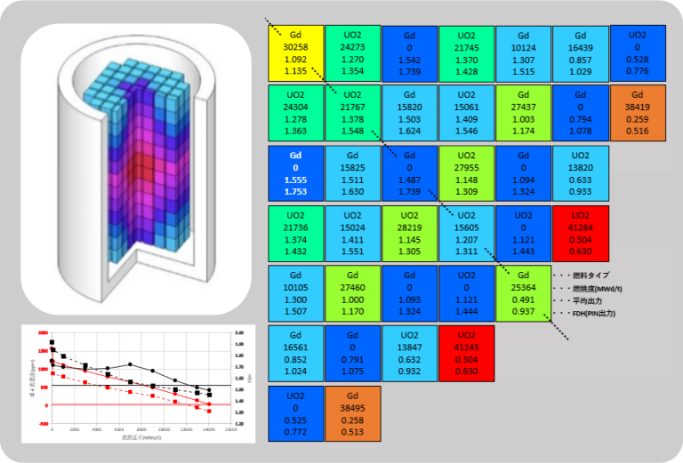We are engaged in various types of analysis, evaluation, and development of analysis tools used in the domains of reactor physics analysis (reactor core design), radiation shielding analysis, radiation exposure evaluation, critical safety analysis for nuclear power plants and also the Rokkasho Nuclear Fuel Reprocessing Facility, radioactive waste processing and storage facilities, nuclear fuel transportation and storage containers, various facilities and equipment involved in handling nuclear fuels and radioactive materials.
SERVICE
01
Reactor physics analysis
By designing the specifications of nuclear fuel used in a nuclear power plant and also the suitable placement of the nuclear reactor, we consider sure, safe, and efficient fuel operation over a planned period. Further, reactor physics analysis is used to perform safety evaluations that ensure integrity of the nuclear fuel for reactor neutronic characteristics required for operation of the reactor and when abnormalities occur.

SERVICE
02
Radiation exposure assessment
By taking into consideration the difference in function of each piece of equipment in a nuclear power plant and different behaviors of different types of radiative materials, we can assess the mass balance and radiation released into the environment by radioactive material located inside the power plant, and also the associated exposure doses to personnel working within a nuclear power plant and the general public in the vicinity of the plant.
The assessment results are reflected in operations planning, facility renewal planning and decommissioning planning, etc that take into consideration safety and reasonableness.

SERVICE
03
Radiation shielding design
Radiation shielding design covers a broad range of areas relating to radiation, including the design of radiation shielding walls within nuclear power plants, the assessment of radiation dosages of equipment, and assessment of the volume of radioactive materials in the back end. Our work in this field includes taking into consideration a range of factors, such as seismic components and transportation to achieve an optimum balance and perform equipment design and operational considerations in order to avoid superfluous design while also maintaining the safety of nuclear facilities and equipment.
Primary analysis codes
MCNP, Phits, DOORS, QAD, G33, ORIGEN, NJOY, FRENDY, ADVANTG

SERVICE
04
Criticality safety design
We perform subcriticality assessments in a variety of areas such as nuclear facilities, the handling of fissile materials, and the transportation and storage of nuclear fuel.
By simulating nuclear fission chain reactions, we determine the arrangement of fissile material and select neutron-absorbing structural materials, and perform assessments and design in order to ensure safety in a variety of situations, such as in the event of an earthquake.
Primary analysis codes
SCALE, MCNP, MVP






